Rava Kesari, How to Make Kesari
Kesari Recipe – Rava kesari is a traditional South Indian dessert made with semolina, sugar, ghee, nuts and raisins. In this post I show you how to make smooth, delicious, aromatic and fluffy kesari with video and stepwise photos. Also known as kesari bath, this 25 minutes sweet is super simple to make, a total crowd pleaser and needs only pantry ingredients. This is a perfect dessert for every occasion, be it a festival, celebration or a weekend family breakfast.
In India, we make many different kinds of halwas, which are the Indian style puddings & rava kesari is one of them. This semolina dessert is made in many regions across India, so the recipes vary widely from one region to other. The version I have shared here is specific to South India.
About Rava Kesari
Rava kesari is a sweet dish from South Indian cuisine. “Rava” is a South Indian word for “semolina” and “Kesari” is an Indian word for “orange or saffron color”, which is the key ingredient in this dish. So rava kesari literally means “semolina that’s been prepared with orange color”.
While making rava kesari, artificial kesari color is added to impart a bright orange color to the dessert. Most often a powder or liquid color is added. However this can be easily replaced with saffron strands like the way I have done. If you do not have saffron use natural edible color.
Kesari is made in most South Indian households & even in Temples to offer the Hindu Gods or deities during Pooja, festivals & auspicious days like Ganesh chaturthi, Navratri, Krishna ashtami etc.
A lot of us also eat rava kesari as a breakfast or as an after meal dessert. It is made so often on every other occasion since it is very quick and simple to make.
How To Make Rava Kesari (Stepwise Photos)
Preparation
1. Heat 2 table spoons of ghee in a heavy bottom pot. Split open 12 cashew nuts and clean them. Fry them until slightly golden.
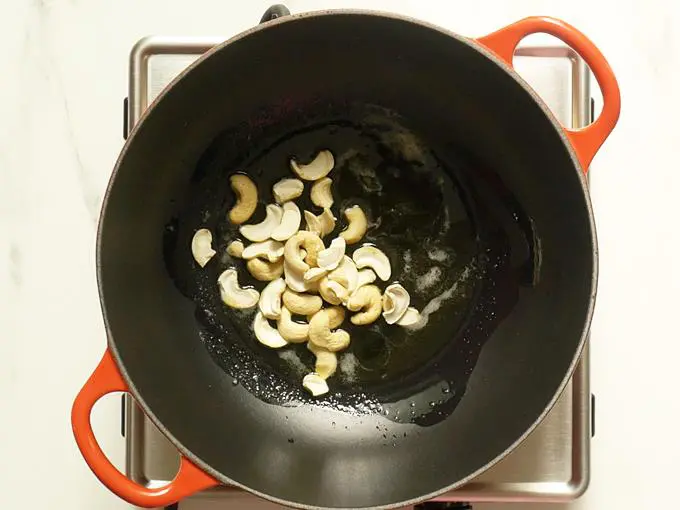
2. Add 12 raisins and fry until they turn plump. Remove them to a plate.
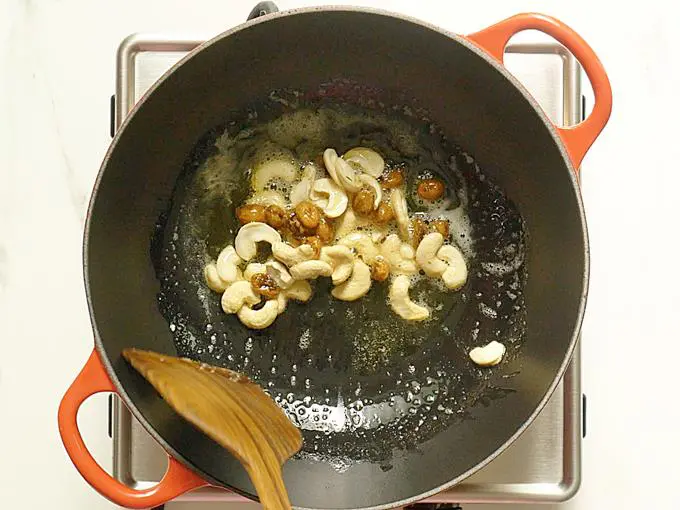
3. Next pour the 1 cup rava. Mix well to coat the rava in ghee.
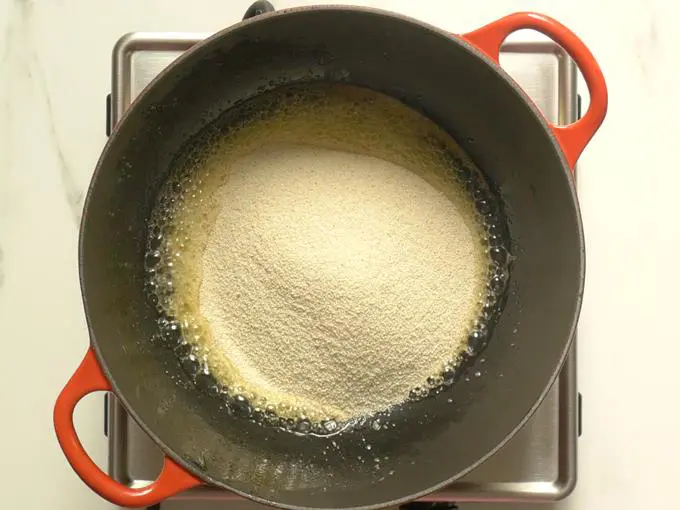
4. Begin to roast the rava well on a low to medium heat until crunchy and slightly aromatic. Do not brown it.
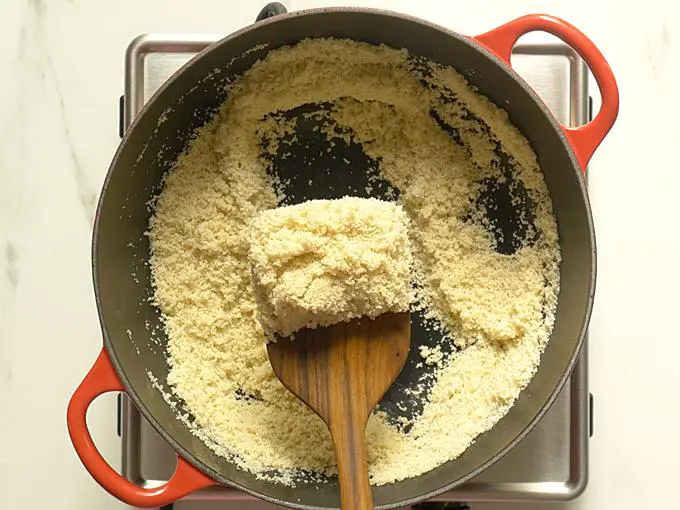
5. While the semolina is getting roasted, bring 2½ cups water to a boil in a pot. You can also use milk or a mix of both. Kesari bath is mostly made with water and not milk.
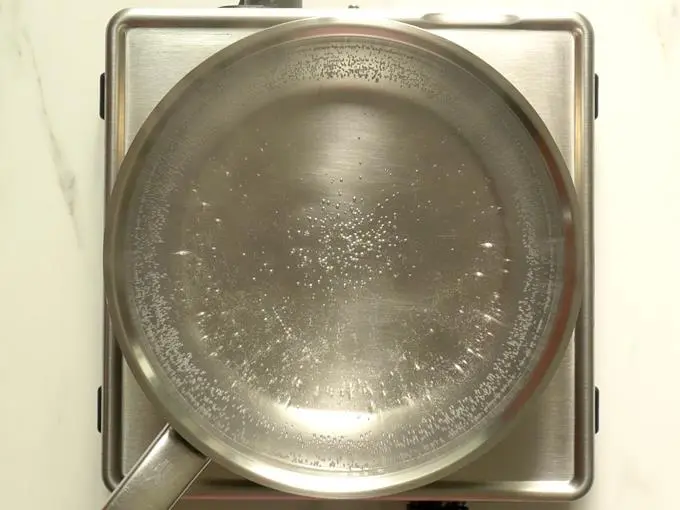
Incorporate water with rava
6. When the water comes to a rolling boil, pour it to the rava slowly in a stream. Stirring consistently with the other hand. Make sure the flame is medium at this stage.
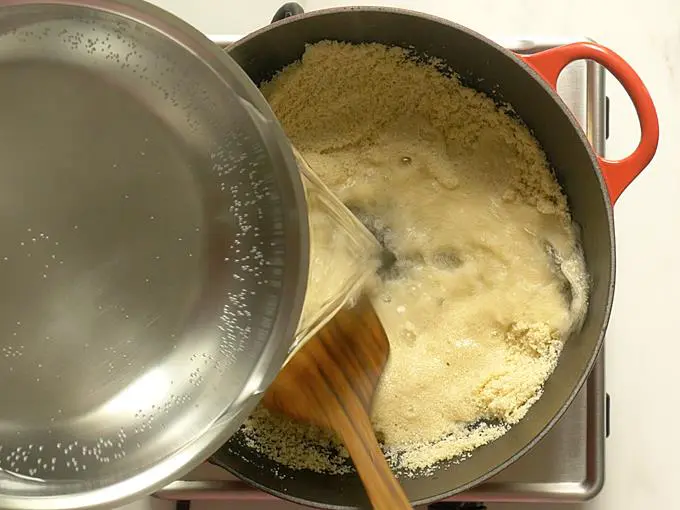
7. There should be no lumps.
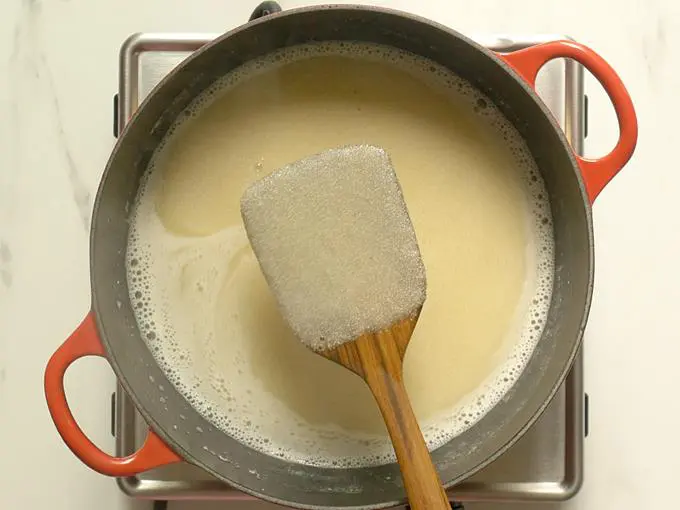
8. Continue to cook stirring consistently until the water is absorbed completely.
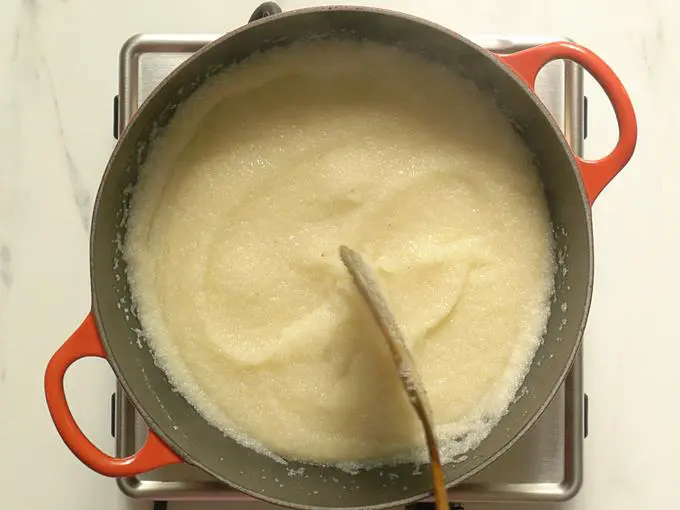
9. Lower the flame and cook covered for 2 to 3 mins.
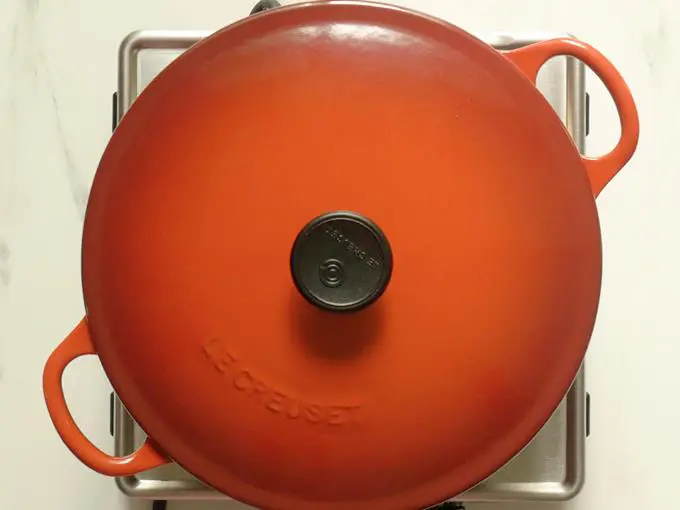
10. Add ¾ to 1 cup sugar and mix well. I use 1 cup. If you prefer low sweet, then add lesser. Sugar melts and makes the mixture gooey. Then continue to cook until all the moisture evaporates.
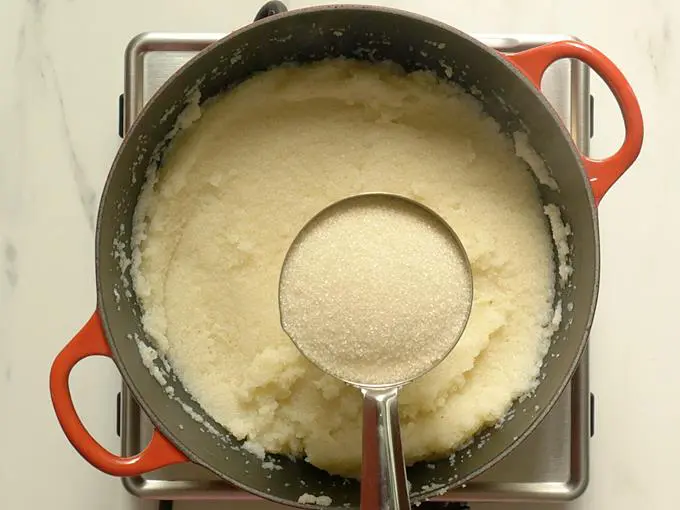
11. Sprinkle ¼ teaspoon cardamom powder and kesari color. I used 2 pinches of saffron soaked in 2 tbsps hot water. If you do not have the kesari, just skip it.
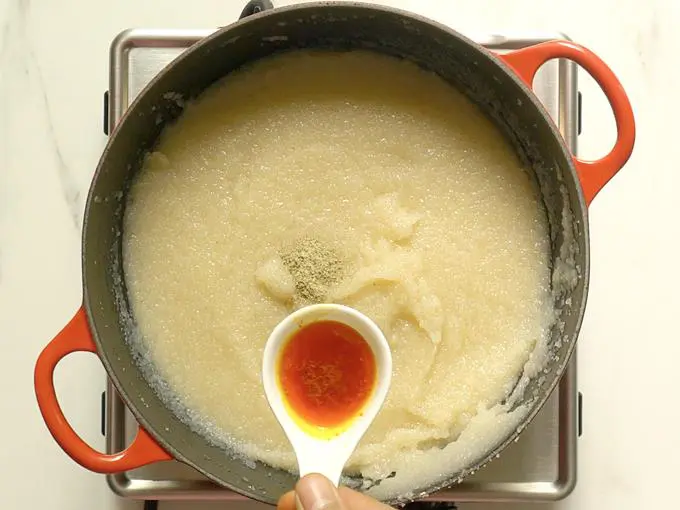
12. Next add 3 to 4 tbsp ghee. I used 3 tbsp.
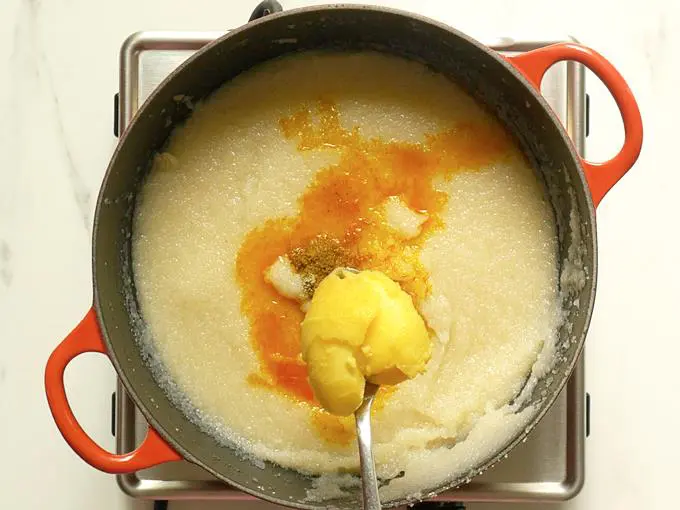
13. Mix well and continue to cook until the mixture leaves the pan. Cook covered for 2 mins. This is optional.
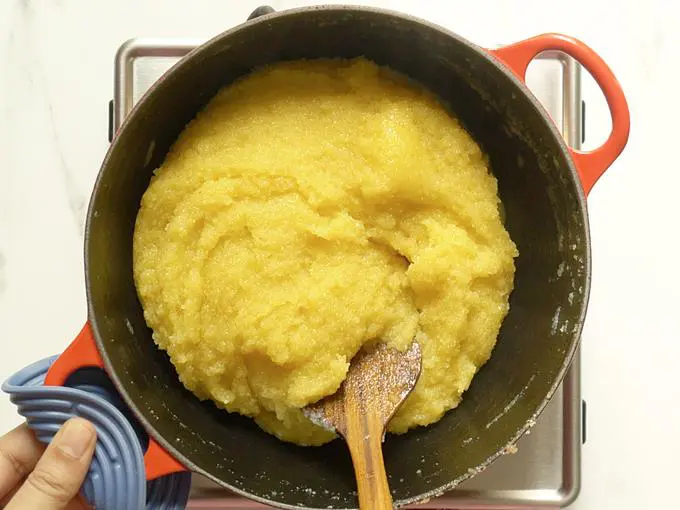
Garnish rava kesari with nuts and raisins. When it cools down you can fluff up with a fork.
Pro Tips
Proportions: The key to make best rava kesari is the right proportion of rava, water and ghee. The proportions shared in this recipe yield soft, light and fluffy kesari that isn’t too greasy. For every 1 cup rava, use 2.5 cups water. If you want a softer & moist melt-in-the mouth kesari, use 3 cups water, 1 cup ghee and 1½ cups sugar. This is the version you can make for celebrations and occasions.
Roasting: Roasting rava in ghee until slightly crunchy and aromatic is very important. Roast on a low flame so semolina does not discolour yet turns crunchy. Well roasted rava will make your kesari fluffy and won’t turn sticky.
Stirring: Stirring consistently while pouring water to the rava is very important to prevent lumps.
Hot water: Make sure the water is hot when you pour the water to the rava. Also ensure the heat is medium to low to avoid splatters.
Ingredients & substitutes
Rava/ semolina: Originally rava kesari is made with fine semolina known as bombay rava. But many households now a days even use golden fine wheat rava or fine bansi rava to make this. The flavor of the one made with whole wheat rava is different from semolina. If you prefer to use the whole grain rava, then use 3 cups water.
Liquid: In this post, I have used water to cook the semolina. You may substitute water with milk. I personally prefer using half water and half milk. Using only milk makes the sweet heavy.
Sweetener: Sugar is the common sweetener used in this recipe. Though jaggery can be used the flavour and the color of the kesari won’t be the same with jaggery. Infact my family does not like jaggery in kesari.
INGREDIENTS (US CUP = 240ML )
- 1 cup semolina or fine rava or suji
- ¾ to 1 cup sugar (prefer organic)
- 2 ½ cups water or milk (refer notes)
- ¼ teaspoon cardamom powder or elaichi powder
- 2 pinches natural kesari color or saffron strands
- 5 to 6 tablespoons Ghee or clarified butter (I used 5 tbsps)
- 12 Cashews (use as needed)
- 12 raisins (use as needed)
INSTRUCTIONS
Preparation
- Heat 2 tbsp ghee in a heavy bottom pot and fry cashews until light golden.
- Then add raisins and fry until they swell up. Remove to a plate and set aside.
- In the same ghee add the rava and fry on a low to medium heat until aromatic and crunchy.
- Do not brown or discolor the rava as the aroma of the rava kesari will change.
- While the rava is getting roasted, pour water to another pot and bring it to a boil.
How to Make Rava Kesari
- When the water turns boiling hot, slowly pour it to the rava by consistently stirring to prevent lumps.
- The water will be absorbed by the semolina soon. Keep stirring and make sure there are no lumps.
- When you see there is no excess water in the pan, then cover and cook on a low flame for 2 to 3 mins. This is just to ensure rava is cooked completely and turns fluffy.
- Add sugar and mix well. Sugar will dissolve and the entire rava kesari mixture turns gooey.
- Keep stirring and cook until the mixture thickens and the moisture is evaporated.
- Then sprinkle cardamom powder, saffron or kesari and ghee. I used about 3 tbsp ghee.
- Mix well and cook for 2 to 3 mins until the rava kesari leaves the pan. Cover and rest for 2 to 4 mins.
- Grease a mould or round cup and then scoop some rava kesari to it. Level the top.
- Invert the bowl or mould to a plate. Gently shake off. Garnish rava kesari with cashews and nuts.
- You can also fluff up the rava kesari with a fork to make it fluffy.
NOTES
- Water: Most people prefer to use 2½ cups water for every cup of rava. If you use more water, you have to use more ghee & even sugar.
- A lot of South Indians consider 1:1:2:3 cups as the perfect ratio for rava:ghee: sugar: water. Meaning for 1 cup rava, 1 cup ghee, 2 cups sugar and 3 cups water is used. These are the ratios used when made for special occasions like wedding and celebrations.
- Do not reduce the quantity of ghee as it make the rava kesari sticky.




0 Comments